 Register on the forum now to remove ALL ads + popups + get access to tons of hidden content for members only!
Register on the forum now to remove ALL ads + popups + get access to tons of hidden content for members only!
|
||||||||
 Best Porn Sites Best Porn Sites
|
Live Sex | Register | FAQ | Members List | Calendar |
| Politics, Current Affairs, Religion Threads Post here for all Politics, Current Affairs, Religion Threads |
 |
|
|
Thread Tools | Display Modes |
|
|
#7641 |
|
Senior Member
Join Date: May 2015
Location: Je Me Souviens
Posts: 149
Thanks: 886
Thanked 3,238 Times in 146 Posts
           |
I have just finished reading "No holding back", written by B.A. Reid; it is an in depht analysis concerning Operation Totalize, in August 1944.
I am not a historian myself, but this is the best available source on this crucial operation as far as I can tell. Reid is quite concerned about details; the firts 150 pages of the book are devoted to the development of the operation and both the artillery barrage plan and the RAF bombing plan are explored with objective criticism. Of course, the use of "Unfrocked Priests" as armoured carriers is discussed in details: the whys hows and whens of the first massive use of armoured carriers in WW2 are well documented. A lot of attention is also paid to German tactical and strategical decisions during the period just before Totalize and during the operation itself The 51st Highland and 2nd Canadian Division operations in Phase I are then described. Then, namely, 1st Polish Armoured and 4th Canadian Armoured Divisons hit and miss operations during Phase II are also explored. The tragic faith of Worthington force is specifically dealt with. The book offers a well balanced criticism of General Simonds leadership and decisions. I personnaly believe he was the best Canadian general of WW2 (In fact, he was born in the UK; Monty appreciated him a lot). At the same time, he was cold and had a WWI "I don't care about casualties " attitude when it came to major operations, although his "invention" of armoured carriers may prove to the contrary. The author, Reid, also offers a very comprehensive analysis of the final results of the operation. Nothing is black or white with him; he understands that being on the offensive against an army possessing superior weapons (88's, MG42's, Panthers and Tigers, to name a few...) is deadly and complicated. There's a lot of appendices to the book. One is devoted to Wittman's death; Reid has made quite a case that 2nd Canadian Armoured brigade's Sherbrooke tank Regiment probably destoyed 007 Tiger. This section is worth the book in itself, believe me... It is highly technical and well illustrated over 20 pages. This book (2004, 491 pages, including references) is a must read. Last edited by cyber200; May 4th, 2016 at 04:07 AM.. Reason: details,in depht |
|
|

|
| The Following 17 Users Say Thank You to cyber200 For This Useful Post: |
|
|
#7642 | |
|
Veteran Member
Join Date: Apr 2014
Location: NZ
Posts: 4,056
Thanks: 70,881
Thanked 41,071 Times in 4,047 Posts
           |
Quote:
https://www.youtube.com/watch?v=mCNz7OC8YIs Interestingly-his gunner, Balthasar 'Bobby' Woll who ended up as an Obersharfuhrer SS (equivalent to a CSM-so a WO2 rank equivalent) who stayed with Wittman right through the war, was not with him on this last occasion, as he was recovering from wounds.Woll went on to command a Tiger in his own right and survived the war and only died in 1996 at the age of 74. A man who deserves at least some of the credit ascribed to Wittman-it was Woll's superb gunnery skills (he seems to have been a 'natural' gunnery marksman) that gave ultimately Wittman his 'Panzer ace' kill record....Wittman fought the tank tactically (and well)-but it was Woll who placed the shot..! Incidentally his (Wittmann) tank ace career only last about 2 years-(42-44) as prior to that he served in StuG assault gun units and the Leibstandarte. Last edited by Dr Pepper; May 4th, 2016 at 04:11 AM.. |
|
|
|

|
| The Following 20 Users Say Thank You to Dr Pepper For This Useful Post: |
|
|
#7643 | |
|
Senior Member
Join Date: May 2015
Location: Je Me Souviens
Posts: 149
Thanks: 886
Thanked 3,238 Times in 146 Posts
           |
Quote:
|
|
|
|

|
| The Following 11 Users Say Thank You to cyber200 For This Useful Post: |
|
|
#7644 |
|
Super Moderator
Join Date: Jan 2009
Location: England
Posts: 26,266
Thanks: 162,480
Thanked 278,821 Times in 26,211 Posts
           |
 The USS Edsall was a veteran ship, rather similar to many sold to the British under Lend-Lease and roughly equivalent to the British V&W class which were the backbone of many anti-submarine groups. She had four funnels, which was very old hat by WW2. She was stationed in the Philippines from 1925 onwards, a familiar figure in the US Far East fleet by 1941, when she happened to be visiting the Dutch East Indies and was assigned to join the British Force Z. Force Z was gone before the Edsall reached Singapore. By February 26th 1942 the situation in the Dutch East Indies was critical. USS Edsall and her sister ship, USS Whipple were escorting a seaplane tender called USS Langley, which had aboard a number of P40E pursuit aircraft intended to reinforce the Dutch air defences at Java. But Langley was sunk by Japanese aircraft stationed on Bali and Edsall and Whipple rescued over 500 survivors. Whipple took most of Edsall's survivors and sailed off west to safety in the Cocos Islands. Edsall was ordered to go to Tjilatjap in Java with 32 USAAF personel rescued from Langley. There were some P40Es in crates delivered there by an earlier voyage and the mechanics were expected to assemble and commission them. It is clear that the people giving these orders had no grasp of the true situation. Tjilatjap and Java were imminently about to fall to Japan and these men would have been captured almost as soon as landing, even if they landed. But meanwhile Admiral Doorman and the ABDA squadron were sunk on February 28th and most of the survivors sunk on March 1st. Edsall was sailing into water newly seized and controlled by the Japanese. It was crazy to send her there, and can only have meant that the people giving the orders didn't know anything. At 15.50 hours local time on 1st March 1942 Japanese forces detected a "light cruiser" which in fact was the Edsall. They had just finished sinking a seaplane tender called USS Pecos which had aboard most of the Langley survivors rescued by Edsall and Whipple and Edsall was probably responding to the distress call of the Pecos. Just afterwards, the Japanese 8" cruiser Chikuma opened fire at 27,000 metres. Shortly after that, a battleship squadron arrived, IJN Hiei and Kirishima, and joined in the attack. Edsall fought a forlorn but very professional last fight. One of her torpedo attacks very narrowly missed Chikuma. In over an hour, two battleships and two heavy cruisers fired 1,335 16" and 8" shells at Edsall, and she was so well handled that only two hits were observed. The Japanese battle report grimly commented that the action was a "fiasco" from their point of view. This was so much ammunition in return for so little a ship that it almost constituted a victory on points for the Americans. In the end, two squadrons of dive bombers were scrambled from nearby Jaoanese carriers and they sank Edsall. She went down at about 17.30 hours local time. Chikuma rescued about 30 survivors but was ordered to stop looking due to a submarine alert. She delivered them to her new home port in Java but they were murdered there. There is some evidence that the officers and crew of Chikuma were offended and annoyed by this crime and had wanted to treat the survivors fairly, respecting them for the brave fight they had made. They weren't the ones to blame. But nevertheless not one man from USS Edsall was allowed to survive. It was despicable. Edsall had the last laugh though. A few weeks before her death, she had sunk a Japanese submarine and captured some code books which were subsequently instrumental in breaking the Japanese naval codes and allowing the Americans to intercept their messages at Midway. The three carriers which jointly sank the Edsall all died at Midway. So her murdered men had their revenge. May the earth lie softly on the grave of the murdered men of the USS Edsall and may the ocean currents lap gently over whatever is left of the men who were lost at sea when she went down.
__________________
To view links or images in signatures your post count must be 0 or greater. You currently have 0 posts. |
|
|

|
| The Following 20 Users Say Thank You to scoundrel For This Useful Post: |
|
|
#7645 |
|
Super Moderator
Join Date: Jan 2009
Location: England
Posts: 26,266
Thanks: 162,480
Thanked 278,821 Times in 26,211 Posts
           |
By January 1943, RAF Bomber Command were addressing problems which had gravely undermined their efforts in the early years of the war. They were refining the pathfinders technique: No.8 Group RAF was formed under Group Captain Donald Bennett, who was promoted to Air Commodore almost immediately. In January 1943, the group was collated from various heavy bomber squadrons which had individually been fitted with Gee Boxes and allotted pathfinder duties, and was an eclectic mix of types, including Stirlings and Wellingtons which were already getting obsolete. Bennett oversaw a modernisation in which the group received Mosquito light bombers, fast and agile aircraft with a long range.
Gee Box signals were being jammed and distorted by the end of 1942 but the RAF had developed a new system called Oboe. It was more clever. working a bit like sonar/asdic. The aircraft received a signal from Ground Station A, retransmitted it to Ground Station A, and simultaneously received and retransmitted a signal to Ground Station B. There was no beam to be distorted. The Oboe equipment relied on knowing where A and B were and knowing how fast radio waves travel, and could triangulate a position. The main limitation was range: the curvature of the earth meant it could not guide aircraft much deeper into Germany than the Ruhr. The Ruhr and the surrounding Rhineland basin were industrial heartlands, very important economically and often cloaked in polluted smog. They had their own smokescreen a lot of the time and were not easy to bomb. One of the first mass Gee Box raids was in March 1942 and was hoping to get the Krupp Works at Essen (just outside Essen actually). Not one bomb came within 5 miles of the Krupp Works, but out of 200 aircraft used, about 33% found Essen and bombed it. This was considered a roaring success, which tells us how ineffective previous navigation used to be, as well as telling us about British views on bombing Germany in WW2.   The Krupp Works and Dortmund (not Essen, but it gives a general idea of the Ruhr) Oboe changed all that. Oboe was so accurate that it uncovered an error in the longitudinal alignment of British ordnance survey maps with maps of the continent. The error radius was about 180 yards in 400 miles. The Krupp dynasty had been casting steel in Essen since 1817: it is where they started in business. By 1939 they had a huge steel plant there and were also manufacturing artillery and equipment for the German army. Unsurprisingly the ThyssenKrupp website doesn't say much about this period of the group's history. At least 20% of the workforce were slaves, many from France (they also manufactured extensively in concentration camps, including Auschwitz). Gustav Krupp, already an old man by then, had played a major role in supporting Hitler's rise to power and in expelling Jews from the German Chamber of Commerce when Hitler appointed him to chair it afterwards. The best thing one can say about Gustav Krupp is that he wasn't really a Krupp. His wife was the heir after her father, exposed as a habitual child molester, shot himself because even the Kaiser was deciding he had to be dealt with. The way things were in those pre-WW1 days, one has to wonder whether he fell or was pushed. His daughter inherited 100% ownership of the Krupp empire and the Kaiser reputedly intervened to make her marry asap a man who understood business; and indeed, no matter how bad his character, no one can say Gustav Krupp did not succeed in purely commercial terms. By WW2 he had extended the empire to a point where it was a key strategic target. On March 5-6 1943, the RAF had another go at the Krupp Works. It was the first raid in the 1943 Battle of the Ruhr. 442 aircraft took part, marking done by 8 Group pathfinders using Oboe. Only 153 aircraft bombed within 3 miles of the marked target, much to Air Commodore Bennett's displeasure. Inability to find the target wasn't the only issue: the truth is that the RAF were not very good at hitting targets at nightime, even when they were marked. The Americans preferred daylight bombing for a reason, and this was the reason: its bloody hard to drop freefall bombs accurately at night. 14 bombers lost that night, others damaged. On March 12-13, the RAF came back, using 457 aircraft, of which 23 were lost. Pollution and ground haze were still a problem, and the defenders had a smoke screen as well. But the weather was fine and clear and 383 aircraft located the target. The pathfinder target markers were very well placed; they were starting to divebomb with Mosquitoes for better precision. The bombing was much more concentrated, although the NW suburbs of Essen were still extensively bombed as well, which RAF Bomber Command considered a success rather than a failure; British people drink tea and play cricket but are not therefore either soft or nice people, and Germany had already bombed us like this rather a lot, so no one in Britain was even pretending to feel sorry about bombing civilians in Germany. However, and for the first time, the Krupp Works was accurately bombed and suffered heavy damage. There was a bigger raid on 4 April 1943. 956 aircraft attacked targets all over the Ruhr. 797 went to Essen, the main target: it was area bombing and the Krupp Works wasn't the target, though it did pick up a bit more damage because some RAF crews found it and decided to attack it anyway, rather than just bomb houses. Area bombing was very much in vogue with RAF Bomber Command, partly because precision bombing was still very problematic even in good conditions, and the conditions over the Ruhr in early April 1943 weren't very good. There were three more attacks on the city of Essen that week of similar magnitude, and then RAF Bomber Command went to Pilsen in Czechoslovakia and attacked the Skoda Works. The next attack on the Krupp Works was hampered by 100% cloud over the target, so pathfinders drops parachute flares from high altitude and when these were between the bomber stream and the clouds, the bomb aimers used them as target indicators. It worked surprisingly well; Krupp Works was hit again, as was most of Essen of course. Sadly, this too was seen in Britain as a good result. It was that kind of war. On 28-29 May there was another raid on Essen not using pathfinders. There were no hits on Krupp and in fact 10 other towns not targeted were all hit more effectively than Essen. Air Chief Marshal Harris was irritated and explained to his group commanders that when there is an Area Target Directive it means that you are supposed to bomb the target and not just any German city will do.  It showed the significance of intelligent target marking and coordination. It showed the significance of intelligent target marking and coordination.Essen got a long breathing space after this but it ended on 25-6 July. Just as it took the first raid of the Battle of the Ruhr, Essen also took the last one. It was a very effective strike. 627 bombers participated, and the works were pinpointed by pathfinders using ground marker flares. All bombers dropped in less than an hour from start to finish. The vast majority of them hit the factory buildings; just over 2,000 imperial tons of high explosives and incendiaries. The Krupp Works ceased to produce because the RAf had finally bombed it just right. It was out of production for the rest of the war because the RAF had managed to get key and irreplaceable plant, not just the buildings. I've seen images of the damage both to the works after this raid and to the town of Essen over the course of this bombing campaign and its very shocking and unpleasant to see. Many people must have died. On the morning of 26 July 1943, the chairman of the group, the retired and elderly Gustav Krupp went to see the damage. He had a massive stroke on the spot and was totally paralysed and unable to speak for the rest of his life (he died in 1950). The bad news is that this meant that the Americans were forced to pass him over for the Nuremberg trials as he was unfit to plead. He would have have qualified for the big trial. But on balance the way he checked out was not much of an escape. He was one of the puppetmasters who made WW2 happen and we need not feel sorry for him. Feel sorry for the people of Essen and what they suffered, but not for Gustav Krupp.
__________________
To view links or images in signatures your post count must be 0 or greater. You currently have 0 posts. |
|
|

|
| The Following 21 Users Say Thank You to scoundrel For This Useful Post: |
|
|
#7646 |
|
R.I.P.
Join Date: Apr 2009
Location: Cloud cuckoo land
Posts: 4,300
Thanks: 26,852
Thanked 54,117 Times in 4,288 Posts
           |
Excellent post as usual, but lets not forget there are many other German companies who were both supporters of Hitler, members of the Nazi party, and used slave and concentration camp labour. Not a few employed former SS Officers after they got out of prison. So Gustav Krupp is to my mind not the only Industrialist that should have been at Nuremberg.
There is also evidence that some of the research utilised by German Drug Companies after the war, was gleaned fro Concentration camp research. The bad German Companies? Volkswagen, Mercedes Benz, Magirus Deustch, Pfifer, Porsche, Telefunken, and many more. |
|
|

|
| The Following 19 Users Say Thank You to rupertramjet For This Useful Post: |
|
|
#7647 |
|
Vintage Member
Join Date: Nov 2009
Posts: 1,490
Thanks: 13,028
Thanked 55,403 Times in 1,513 Posts
           |
Hi, saw these pictures of the Spitfire. I think impressive and a superb piece of engineering. Not taking anything away from aircraft manufactured anywhere else during the war but the Spitfire stands out. The Hurricanewas a workhorse, did more damage than the Spitfire but the grace and beauty of the Spitfire was undeniable.
I then went back over my apprenticeship in printing, aged 15, in 1968. I worked with one guy that was a navigator on Wellington bombers, another was a rear gunner on Lancaster's. Another was army and captured by the Japanese. Forced to build the Burmese railway. He was a big bloke, 6'4" but never got over the malnutrition he suffered. Legs like matchsticks. His friend had his back broken when a tunnel they were forced to dig collapsed. He died some days later. As I moved into another company during my apprenticeship, I met others. One that had the unsavoury task of clearing body parts from tanks that had been destroyed, German as well as British. Another was a mechanic in the RAF, his job was to strip and rebuild Merlin engines of Spitfires. Onward to national newspapers, worked with people that had done the desert run with Montgomery, then like my Uncle as he used to say, came home the "pretty" way through Italy. the "pretty" way being via Monte Cassino. In a ditch, one of my good friends lost 2 of his mates. He survived. Nearly all of these brave, very brave men are now dead. But I still remember them. So, as a tribute to all those brave young men, some just mere boys, I post these pictures of the Spitfire, without wishing to denigrate the memories of any other of the forces during WW11. 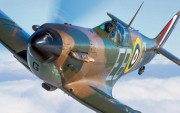  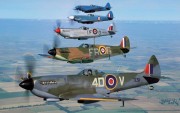       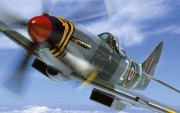   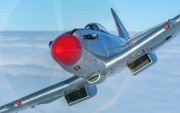 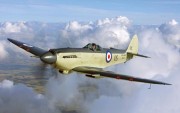    Photos by John Dibbs. 1.Soaring into the skies above the green and pleasant land they so spectacularly fought to defend 76 years ago, these are some of the last airworthy Spitfires left. The Battle of Britain memorial flight's Merlin powered Mk IIa Spitfire P7350. 2.Using the skill and experience of former RAF pilot Tim Ellison, John Dibbs was able to fly to within 15ft of different Spitfire marks to take these photographs.Spitfire AR614 over the White cliffs of Dover. 3.The stunning pin-sharp images of most of the 55 flying Spits in the world have been made into a new book 'Spitfire - The Legend Lives On' to mark the 80th anniversary of the Spitfire's maiden flight. 4.Mk Vb Spitfire BM597 landing on a grass strip 5.Reaching heights of up to 9,000ft and speeds of 250mph, he overcame extreme wind and noise conditions to shoot through an open canopy with a handheld camera to take the remarkable images.A Mk IX Spitfire PL344 (front) and Mk XVI Spitfire TD248 6. Spitfire NH749 in Indian colour scheme was built at Supermarine in Aldermaston and powered by a Rolls Royce Griffon engine 7. The most original Spitfire still flying today, Mk IX MH434, that was built in 1943, flown by a South African flying Ace in the war and has never been subject to a re-build 8.Mr Dibbs, 50, said his line of work has taken him on over 1,100 photographic sorties over the last 20 years. Most of the incredibly-detailed snaps of the last Spitfires were shot in the last seven years over southern England. He said: "I am thrilled with the book. I am an air-to-air photographer so I fly in one like-for-like plane to shoot another. Seven Spitfires and two Hurricanes above the clouds 9."A lot of people think the pictures are fake because they are so close up but it is due to Tim's skill as a pilot to get the plane exactly where I want it to be that enables me to get these pictures. But one of the most exhilarating things is about how close you get." Rolls Royce's own Spitfire PS853, an unarmed, high-altitude photo reconnaissance aircraft, built at Supermarine, Southampton. Powered by the Rolls Royce Griffon engine with a top speed of 446mph and a ceiling of 42,000ft 10."Sat atop the English countryside with a MkI or Mk V off your wing is not something you just witness, you feel it." Mk XVIII Spitfire TP280 powered by a Rolls Royce Griffon needed a five bladed propeller to handle the increased power 11."It is an extreme working environment up there. I always shoot Spitfires through clean air and when the canopy is open it gets a bit chilly up there. I have to overcome the wind and slipstream which are incredibly strong as well as the noise and speed to do my work but I have been doing it long enough not to get freaked out or air sick." Mk 3 Seafire PP972, the Royal Navy version built for Aircraft carriers and powered by a Rolls Royce Merlin engine 12. Mk IX Spitfire PL344 (front) and Mk XVI Spitfire TD248 13.Mr Dibbs, originally from north London but now lives in Seattle, US, said his aim was to capture Spitfires that have a combat history. While the majority fought the Luftwaffe in World War Two one of them is the last to 'fire its guns in anger on King's business' in the Malayan Emergency in the 1950s. Spitfire SM845 in post-war colour scheme was built at Supermarine in Southampton and powered by the Rolls Royce Griffon 67 engine 14.Mr Dibbs, who has photographed Concorde, the Red Arrows and F16 planes before, praised the skill of the Spitfire pilots to fly in formation with Mr Ellison's camera aircraft. Seafire SX336, the Royal Navy version built for Aircraft carriers and powered by a Rolls Royce Griffon engine 15."The Spitfire is probably the most famous and beautiful World War Two plane in the world. This book is to honour the veterans who flew them and there is no finer compliment than to have one tell me I have captured the spirit of the Spitfire in my photographs." Mk XlV Spitfire MV268 with the wings clipped to improve low level performance and roll rate 16.Squadron Leader Geoffrey Wellum DFC, who flew Spitfires in the Battle of Britain, has written the foreword for the book. He said: "This book contains detailed photographs of the very highest quality taken by John Dibbs. This book is a must for all those who have a love and admiration for the Spitfire." Spitfire - The Legend Lives On has been written by author Tony Holmes and is published by Osprey and costs £30. Mk Vlll Spitfire MT928 built in Southampton in 1944. 17. Photographer John Dibbs from London, all credit to him. |
|
|

|
| The Following 25 Users Say Thank You to pudpuller For This Useful Post: |
|
|
#7648 |
|
Super Moderator
Join Date: Jan 2009
Location: England
Posts: 26,266
Thanks: 162,480
Thanked 278,821 Times in 26,211 Posts
           |
As the war went on the proportions of the Spitfire changed a little bit due to engine development. The Series 60 Merlin engine was a lot more powerful and had a better power to weight ratio than earlier models of the engine, but was longer due to the presence of a second-stage supercharger and an extra cooling radiator. Later in the war, the Merlin was replaced with a new generation in-line engine, the Rolls Royce Griffon, 37 litre capacity instead of 27 litre was with the Merlin. The Griffon was surprisingly small, given the increase in capacity, reflecting RR's experience from improving the Merlin. They had changed the component layout to use space more effectively, and introduced a hollow crankshaft to be used as an oil conduit, which enabled them to improve oil distribution to the bearings and reduce heat stress as well. The Griffon wasn't an improved Merlin but a totally different design with a different design brief: it was conceived for the Royal Navy, who wanted it for strike aircraft launched from carriers, and was designed with a single stage supercharger for best performance at low altitudes. It was adapted for the Spitfire rather than designed for it.
The first operational Griffon engined Spitfire was the Mark XII (Mark Twelve). It had short range, only 380 miles on internal fuel, and this was mitigated, though hardly cured, by adding two wing mounted fuel tanks with 14 gallons in each. It had clipped square wing tips, which IMHO spoils the appearance a lot; but which made it exceptionally manoevrable low down. It saw minimal combat because German pilots preferred not to mix it with Spitfires below 20,000 feet anyway, partly because by then the Battle of Germany was being fought and Spitfires below 20,000 feet were not usually protecting the bombers. The German pilots were after the bombers and would only mix it with Allied fighters as a means to that goal. Iin 1944 the Mark 12 Spitfire became the tool of choice for intercepting V1 rockets due to its speed at low altitudes and its four 20mm cannons, but it was already being phased out in favour of the Mark 14, which had a Griffon engine with a two-stage supercharger. In the photo gallery on Pudpuller's post we can see that some of the surviving Spitfires are longer than others. The engines are what make the difference.
__________________
To view links or images in signatures your post count must be 0 or greater. You currently have 0 posts. |
|
|

|
| The Following 19 Users Say Thank You to scoundrel For This Useful Post: |
|
|
#7649 |
|
Super Moderator
Join Date: Jan 2009
Location: England
Posts: 26,266
Thanks: 162,480
Thanked 278,821 Times in 26,211 Posts
           |
__________________
To view links or images in signatures your post count must be 0 or greater. You currently have 0 posts. |
|
|

|
| The Following 15 Users Say Thank You to scoundrel For This Useful Post: |
|
|
#7650 |
|
R.I.P.
Join Date: Apr 2009
Location: Cloud cuckoo land
Posts: 4,300
Thanks: 26,852
Thanked 54,117 Times in 4,288 Posts
           |
Enjoy it! We will await you critic of your visit!
|
|
|

|
| The Following 14 Users Say Thank You to rupertramjet For This Useful Post: |
 |
|
|